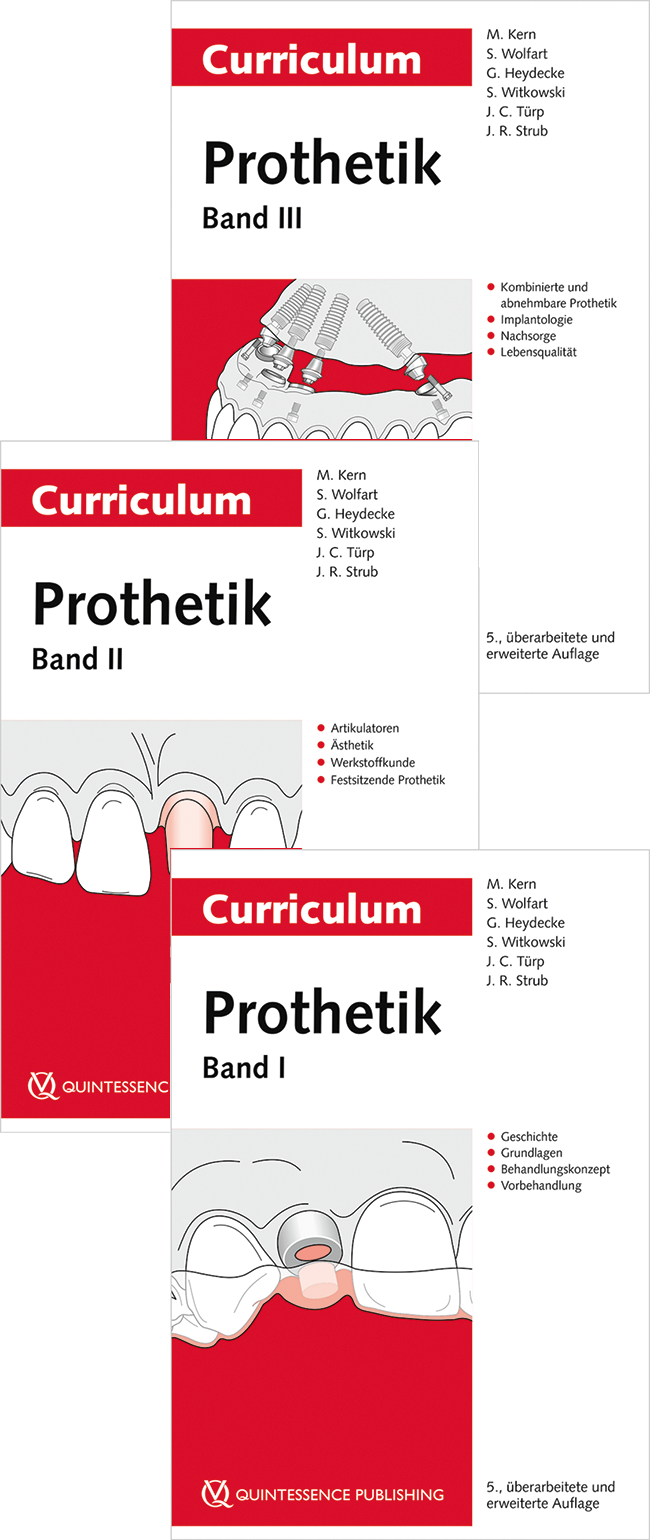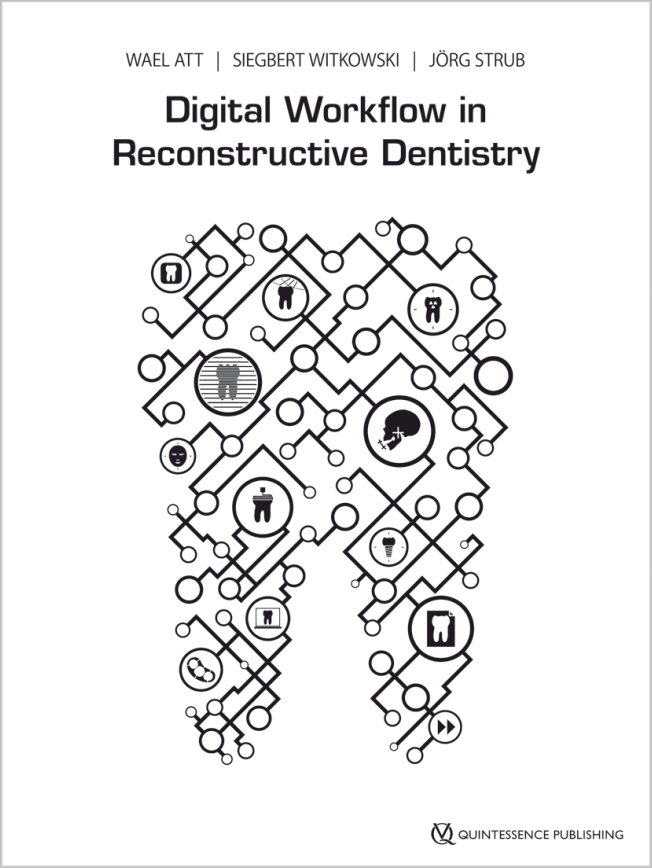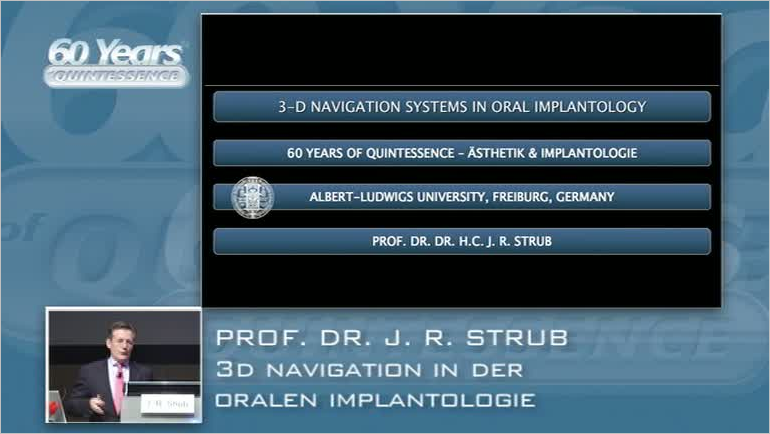Implantologie, 4/2017
Seiten: 7-25, Sprache: DeutschStrub, Jörg R. / Neukam, Freidrich W. / Hürzeler, Markus B. / Witkowski, SiegbertImplantologie 1993;1:7-25Implantologie, 4/2017
Seiten: 385-388, Sprache: DeutschTetsch, Peter / Tetsch, Jan / Strub, Jörg R. / Buser, Daniel / Kirsch, AxelWie kamen Sie zur Implantologie?Zur Feier des 25-jahrigen Jubiläums der IMPLANTOLOGIE haben wir Prof. Daniel Buser, Dr. A. Kirsch, Prof. Jörg R. Strub sowie Prof. Peter Tetsch und Dr. Jan Tetsch (als Vater-Sohn-Gespann) - alle erfahrene Spezialisten auf dem Gebiet der Implantologie - gefragt, wie Sie zur Implantologie gekommen sind, was sich im Laufe der Zeit geändert hat und wo die Reise ihrer Meinung nach hingeht.
Implantologie, 1/2015
Seiten: 109-110, Sprache: DeutschChristmann, Marin / Strub, Jörg R.Quintessenz Zahnmedizin, 4/2013
ProthetikSeiten: 447-456, Sprache: DeutschGüß, Petra C./Selz, Christian F./Steinhart, Yann-Niclas/Stampf, Susanne/Strub, Jörg R.Ergebnisse nach 7 JahrenIm Rahmen einer prospektiven klinischen Split-Mouth-Studie erfolgte eine Nachuntersuchung vollkeramischer Teilkronen im Seitenzahnbereich über einen Zeitraum von 7 Jahren. Miteinander verglichen wurden Restaurationen aus gepresster Lithiumdisilikatkeramik (IPS e.max-Press) und aus CAD/CAM-gefertigter Glaskeramik (ProCAD). Das Patientenkollektiv bestand aus 25 Personen, die mit insgesamt 80 vollkeramischen Teilkronen (40x IPS e.max-Press und 40x ProCAD) auf vitalen Molaren versorgt wurden. Für die Herstellung der Restaurationen kamen hierbei das CAD/CAM-Verfahren Cerec 3 bzw. Cerec Inlab sowie das IPS e.max-Press-Verfahren zum Einsatz. Die klinische Nachuntersuchung der vollkeramischen Teilkronen erfolgte mittels der modifizierten USPHS-Kriterien. Nach einem Beobachtungszeitraum von 7 Jahren betrug die prospektive Kaplan-Meier-Überlebensrate 100 % für die IPS e.max-Press-Restaurationen und 97 % für die ProCAD-Teilkronen. Aufgrund einer Fraktur musste eine ProCAD-Teilkrone nach 9 Monaten Tragedauer ausgetauscht werden. Beide Restaurationsformen wiesen über die Zeit eine Abnahme der Randqualität und eine vermehrte Randverfärbung auf. Die IPS e.max-Press-Teilkronen zeigten eine zunehmende Oberflächenrauigkeit und farbliche Abweichungen. Diese klinischen Langzeitergebnisse deuten darauf hin, dass die beiden untersuchten Werkstoffe für die Indikation der vollkeramischen Teilkrone im Seitenzahnbereich geeignet sind.
Schlagwörter: Keramik, Teilkronen, Presskeramik, Lithiumdisilikatkeramik, CAD/CAM-Glaskeramik
Implantologie, 1/2013
Seiten: 3, Sprache: DeutschStrub, Jörg R.International Journal of Oral Implantology, 2/2012
PubMed-ID: 22866289Seiten: 123-136, Sprache: EnglischArnhart, Christoph / Kielbassa, Andrej M. / Martinez-de Fuentes, Rafael / Goldstein, Moshe / Jackowski, Jochen / Lorenzoni, Martin / Maiorana, Carlo / Mericske-Stern, Regina / Pozzi, Alessandro / Rompen, Eric / Sanz, Mariano / Strub, Jörg R.Objectives: This randomised, controlled multicentre trial aimed at comparing two versions of a variable-thread dental implant design to a standard tapered dental implant design in cases of immediate functional loading for 36 months after loading.
Materials and methods: 177 patients (325 implants) were included at 12 study centres and randomly allocated into one of three treatment groups: NAI (variable-thread design, NobelActive internal connection), NAE (variable-thread design, NobelActive external connection) and, as control, NR (standard tapered design, NobelReplace tapered groovy). Inclusion criteria concerned healed bony implant sites and feasibility for immediate loading. Clinical and radiographic examinations were performed at implant placement and after 3, 6, 12, 24 and 36 months. The outcome measures were marginal bone remodelling (primary outcome), implant survival and success, papilla score, plaque accumulation, and bleeding on probing.
Results: 127 patients (NAI: 45, NAE: 41, NR: 41) were followed-up and evaluated after 36 months. No significant differences in cumulative survival rates were seen for the groups (NAI: 95.7%; NAE: 96.3%; NR: 96.6%). In all groups, bone remodelling occurred during the first 3 months, with stable or even increasing bone levels after the initial remodelling period. The bone remodelling from insertion to 36 months for the NAI group (-0.89 ± 1.65 mm) was comparable (P = 0.98) to that of the NR group (-0.85 ± 1.32 mm). The NAE group showed comparable bone remodelling during the first year, with an increase in following years resulting in significantly less overall bone loss (-0.16 ± 1.06 mm) (P = 0.041). Overall improvement in papilla size was observed in all treatment groups.
Conclusions: Over 36 months, the results show stable or improving bone levels for all treatment groups after the initial bone remodelling seen during the first 3 months after placement. The variable- thread implants showed results comparable to those of standard tapered implants in cases of immediate function, and therefore can be considered as a treatment option for immediate loading.
Schlagwörter: dental implant, peri-implant bone remodelling, soft tissue evaluation, variablethread design
The International Journal of Oral & Maxillofacial Implants, 2/2011
PubMed-ID: 21483882Seiten: 290-303, Sprache: EnglischBateli, Maria / Att, Wael / Strub, Jörg R.Purpose: The aim of this article was to evaluate the effectiveness of various implant neck configurations in the preservation of marginal bone level as well as to identify the available scientific evidence.
Materials and Methods: Online and hand searches of the literature published from 1976 through 2009 were conducted to identify studies dealing with modifications in the implant neck area and marginal bone loss for at least a 5-year observation period. The search terms that were used, alone or in combination, were "implant neck," "marginal bone loss," "neck design," "bone resorption," "bone remodeling," and "implant collar." Relevant studies were selected according to predetermined inclusion and exclusion criteria.
Results: The initial search yielded 3,517 relevant titles and revealed eight different implant neck configurations and/or methods suggested for the preservation of marginal bone. These methods included changes in implant neck length and design, implant surface characteristics, implant diameter, and/or insertion depth; the addition of microthreads; the use of one-piece implants; and the concept of platform switching. After subsequent filtering, 20 studies were finally selected and involved the following methods: the use of microthreads (1 study); modifications in implant surface characteristics (11 studies), implant diameter (4 studies), or insertion depth (2 studies); the use of one-piece implants (3 studies); and platform switching (1 study). Because of the heterogeneity of the studies, it was not possible to analyze the data statistically. No evidence was found regarding the effectiveness of any specific modification in the implant neck area in preserving marginal bone or preventing marginal bone loss.
Conclusion: The current literature provides insufficient evidence about the effectiveness of different implant neck configurations in the preservation of marginal bone. Long-term randomized controlled clinical trials are needed to elucidate the effects of such modifications.
Schlagwörter: bone remodeling, bone resorption, implant collar, implant neck, marginal bone loss, neck design
The Journal of Adhesive Dentistry, 1/2008
DOI: 10.3290/j.jad.a13090, PubMed-ID: 18389735Seiten: 41-48, Sprache: EnglischStappert, Christian F. J. / Abe, Pia / Kurths, Volker / Gerds, Thomas / Strub, Jörg R.Purpose: To evaluate preparation designs of compromised cusps and whether or not they influence masticatory fatigue, fracture resistance, and marginal discrepancy of ceramic partial-coverage restorations (PCRs) luted on mandibular molars.
Materials and Methods: Sixty-four caries-free molars were equally divided into four groups. Control group NP received no preparation (NP). Group B-IN received a basic inlay (IN) preparation with buccal (B) cusp conservation and occlusal reduction of both lingual cusps. Group B-ON was prepared in the same way, except buccal cusps were prepared with an angle of 45 degrees to the occlusal plane (buccal onlay). Group B-OV preparation was similar to group B-ON, but buccal cusps received a further shoulder preparation on the buccal aspect (buccal overlap). Forty-eight all-ceramic IPS e.max Press PCRs were fabricated and luted adhesively. Specimens underwent mouth-motion fatigue (1.2 million cycles, 1.6 Hz, 49 N) and 5500 thermal cycles (5°C/55°C). Fracture patterns were observed. Surviving specimens were loaded until fracture. Marginal discrepancies were examined.
Results: Only one specimen of group B-ON fractured during fatigue. Median fracture loads (N) [IQR=x.25-x.75]: group NP = 1604 N [1182-1851 N], group B-IN = 1307 N [1262-1587N], group B-ON = 1396 N [817-1750N], group B-OV = 1205 N [1096-1542N]. No significant differences in fracture resistance were found between restored molars and unprepared teeth (p >= 0.18). Different preparation designs showed no significant influence on PCR fracture resistance. Mouth-motion fatigue caused a significanty decrease of marginal accuracy in groups B-IN (p = 0.009) and B-ON (p = 0.008). Marginal discrepancy values of groups B-IN and B-OV were significantly different after fatigue (p = 0.045).
Conclusion: Ceramic coverage of compromised cusps did not demonstrate an increase of fracture resistance after fatigue when compared to less invasive partial-coverage restorations. However, enhanced exposure of restoration margins to occlusal wear could result in more extensive marginal discrepancies.
Schlagwörter: fracture resistance, marginal discrepancy, partial coverage restoration, ceramic, fatigue
Quintessenz Zahnmedizin, 10/2007
ZahnerhaltungSeiten: 1035-1039, Sprache: DeutschButz, Frank/Heydecke, Guido/Bleise, Wolfgang H./Strub, Jörg R.Ziel der Studie war es, den Einfluss von Wurzelstiften auf die Frakturfestigkeit unterer Molaren bei definiertem Hartsubstanzverlust zu untersuchen. Dazu wurden 96 untere Molaren mit standardisierten okklusal-distalen Kavitäten präpariert, wurzelgefüllt und in sechs Gruppen à 16 Zähne aufgeteilt. Die Zähne der Gruppe 1 wurden mit Stiften aus Zirkoniumdixoid (ZrO2) und Kompositfüllungen versehen. Bei Gruppe 2 kamen ZrO2-Stifte sowie Keramikinlays und bei Gruppe 3 Titanstifte sowie Metallteilkronen zum Einsatz. Die Zähne der Gruppen 4 bis 6 wurden wie die der Gruppen 1 bis 3, aber ohne Wurzelstift versorgt. Nach Kausimulation mit simultanem Thermocycling wurden alle Prüfkörper in einer Universalprüfmaschine bis zum Bruch belastet. Die Bruchlasten der mit Kunststofffüllungen und Keramikinlays versorgten Gruppen waren statistisch signifikant kleiner als die der Metallteilkronen, lagen jedoch oberhalb der in der Literatur beschriebenen maximalen Kaukräfte im Seitenzahngebiet. Der Einsatz eines Wurzelstiftes hatte in dieser Studie keinen Einfluss auf die ermittelten Frakturfestigkeiten. Bei wurzelgefüllten Molaren mit moderatem Hartsubstanzverlust scheinen folglich adhäsive Restaurationen allein und ohne Kombination mit Wurzelstiften ausreichend vor Zahnfrakturen zu schützen.
Schlagwörter: Molar, Wurzelfüllung, Wurzelstift, Frakturfestigkeit, Laborstudie
The International Journal of Prosthodontics, 1/2007
PubMed-ID: 17319368Seiten: 73-78, Sprache: EnglischDenner, Nana / Heydecke, Guido / Gerds, Thomas / Strub, Jörg R.Purpose: The aim of this clinical 2-year follow-up study was to compare the postoperative sensitivity of abutment teeth restored with full coverage restorations retained with either conventional glass-ionomer cement or a new adhesive resin cement containing 4-methacrylolyloxyethyl trimellitate anhydride (4-META).
Materials and Methods: Sixty patients received 120 full-coverage restorations on vital abutment teeth, cemented with either a glass-ionomer cement (Ketac-Cem) or a new adhesive resin cement (Chemiace II). A randomized split-mouth design and a patient double-blind data acquisition protocol were used. The teeth were examined before cementation, after 1 week, and after 6, 12, and 24 months.
Results: With regard to postcementation sensitivity, a low incidence was observed for both groups. With the adhesive resin cement, little postoperative hypersensitivity was observed after 1 week (13.3%), 6 months (5.9%), 12 months (2.1%), and 24 months (none); results were similar with the conventional glass-ionomer cement Ketac-Cem after 1 week (5.9%), 6 months (5.9%), 12 months (6.4%), and 24 months (none). After 6 months, 2 teeth of the Chemiace II group showed no sensitivity. Endodontic treatment was carried out for these 2 abutment teeth. After 24 months, no cases of postoperative hypersensitivity were recorded for either group.
Conclusion: In this study, the incidence of postoperative hypersensitivity after cementation of full-crown restorations with a conventional glass-ionomer cement and a new adhesive resin cement was similar.






